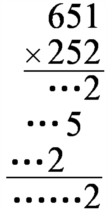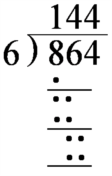Nemeth Code Rules
RULE X--OMISSIONS
This page is under heavy construction
Many examples on this page may be considered incorrect.
Please refer to the Table of Contents page to find Rules that have been thoroughly modified and proofed.
General Omission Symbol =
§57. Omissions: A large number of signs are employed in ink print to denote omitted mathematical or literary material. When a question mark, either by itself or in combination with hyphens or dashes, or a blank spaces is employed in ink print to denote omission, the general omission symbol must be used in the transcription. The number of general omission symbols to be used must be the same as the omission signs in ink print. When a dash is used to denote omission in ink print, the long dash must be used in the transcription. If an omission sign is used in ink print for which this Code provides no representation, this sign may be represented by drawing it in, or the transcriber may devise a braille symbol to represent it. In all other cases, the omission symbol which is used must correspond to the sign which appears in ink print. All of these rules apply unless work is spatially arranged for computation, in which case see §58.

|
verbose semantics |
left-parenthesis 5 comma right-parenthesis plus left-parenthesis comma 15 right-parenthesis equals left-parenthesis 7 comma 13 right-parenthesis |

|
§58. Omissions in Work Arranged Spatially for Computation: In work arranged spatially for computation, only the general omission symbol may be used in braille regardless of how the omission is denoted in ink print. In addition, the number of general omission symbols to be used must be the same as the number of omission signs which occur in ink print.

+70
33333
===
|
verbose semantics |
StartLayout
1st Row
40
2nd Row
plus 70
3rd Row
question-mark question-mark question-mark
EndLayout
|

|

-===
333333
453
|
verbose semantics |
StartLayout
1st Row
642
2nd Row
minus question-mark question-mark question-mark
3rd Row
453
EndLayout
|

|

@*252
33333333
===2
===5
===2
33333333
=====2
§59. Spacing with Omissions: The general omission symbol should be spaced in the same manner as the material which it replaces. Other omission symbols must be spaced in accordance with the rules governing the spaces of those symbols.













